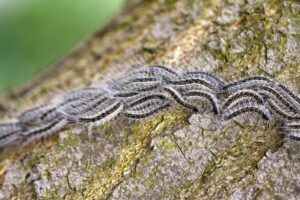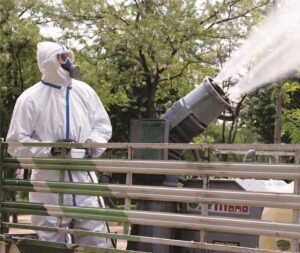Oak Processionary Moths (OPMs) are pests that are now commonplace across Europe, especially during spring and summer[1]. In its caterpillar form, this invasive species is not only harmful to trees but also poses a threat to humans. Workers in forestry, road construction, pest control, and landscaping are particularly exposed to this hazard, which can cause varying allergic reactions[2].
Here Andrzej Palka, EMEA Marketing Manager for DuPont Personal Protection, looks at how Personal Protective Equipment (PPE) plays a primary role in preventing human contact with the caterpillars, thus protecting workers from harm.
Why are oak processionary moths a risk to humans?

The Oak Processionary (Thaumetopoea processionea) caterpillars on the move on a tree in spring in the Netherlands.
OPM caterpillars have fine hairs on their bodies, which contain a protein called thaumetopoein. This protein can trigger allergic reactions when it comes into contact with human or animal skin. Symptoms include itching and skin inflammation. In some cases, fever and dizziness also occur as well as eye and respiratory tract irritation.
Persons who encounter OPM caterpillars should seek medical assistance as the severity of allergic reactions differs from person to person. Unfortunately, the sensitivity to thaumetopoein and the intensity of the allergic reaction increases with each exposure. For this reason, every effort should be taken to avoid contact with OPM caterpillars even when exposure is limited in duration or frequency.
Workers at risk of exposure
Forestry, road construction, and landscaping and maintenance company workers are most at risk of exposure to OPM caterpillars. Some tasks bring workers into direct contact with the caterpillars, like the removal of nests to control the population. OPM caterpillars restrict themselves almost exclusively to oak trees. It is, therefore, important to be vigilant when working near or on oak trees, looking out for caterpillars or nests on the trunk and branches.
However, caterpillars also shed their hairs under stress. These hairs can be carried by the wind or fall on the ground, which, potentially, can make workers vulnerable to thaumetopoein allergic reactions without even coming into contact with a caterpillar. This makes the use of PPE vital for workers operating in areas where OPM caterpillars may be present.
Protecting workers against oak processionary moths

Personal protective equipment is the last line of defence against exposure to OPM caterpillar hairs. Workers should wear protective clothing that covers their entire body to remove all potential points of contact. PPE solutions made using the DuPont™ Tyvek® and Tychem® materials are designed to provide the highest level of protection. Here are some of the key items to consider when selecting PPE for OPM protection:
Coveralls
Tyvek® 600 plus coveralls combine Type 4 performance with the comfort, durability, protection, and comfort of a Tyvek® garment. Thumb loops keep the sleeves in position, while elasticated wastes enable workers to move freely. These coveralls are also available with socks.
Tyvek® 800 J coveralls offer Type 3 protection in a breathable fabric. These coveralls protect workers against water-based inorganic chemicals under pressure. Like Tyvek® 600 plus, Tyvek® 800 J coveralls have self-adhesive chin flaps.
Footwear
DuPont™ Tyvek® IsoClean® IC458 overshoes have slip retardant soles for a good grip for workers in all conditions.
The Tyvek® 500 Boot cover is a knee-length overboot that is easy to wear and maximizes comfort and protection thanks to its elasticated top, fixation ties and stitched internal seams. This overboot is also available in an antislip version featuring a slip-retardant sole.
Conclusion
Oak Processionary Moths pose a health risk to workers in forestry, construction and other industries, especially during spring and summer. Workers should be aware of their surroundings and wear the appropriate personal protective equipment to prevent exposure. This protection is vital as allergic reactions can intensify, the more often a person is exposed.
[1] https://www.forestresearch.gov.uk/tools-and-resources/fthr/pest-and-disease-resources/oak-processionary-moth-thaumetopoea-processionea/
[2] https://www.ecarf.org/en/oak-processionary-moth-symptoms-can-occur-well-beyond-the-summer/
Approaches to managing the risks associated Musculoskeletal disorders
In this episode of the Safety & Health Podcast, we hear from Matt Birtles, Principal Ergonomics Consultant at HSE’s Science and Research Centre, about the different approaches to managing the risks associated with Musculoskeletal disorders.
Matt, an ergonomics and human factors expert, shares his thoughts on why MSDs are important, the various prevalent rates across the UK, what you can do within your own organisation and the Risk Management process surrounding MSD’s.



